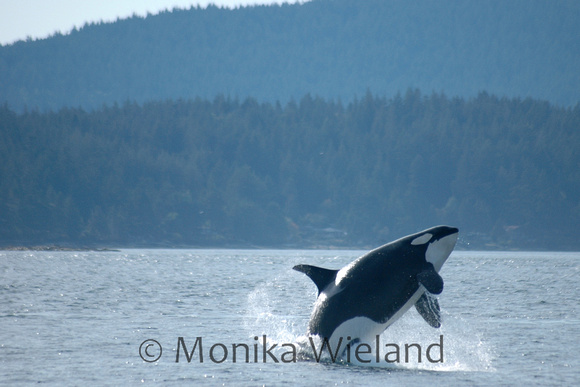Last year on November 2nd, the Day of the Dead, I wrote a blog post honoring the Southern Resident Killer Whales that we had lost during the preceding year. I'd like to make this an annual tradition, so here's my second annual Dia de Los Muertos tribute.
 |
| J1 Ruffles, estimated birth year 1950 |
I've already written extensively about Ruffles in a blog post that you can read here, and also honored him with a photo gallery that you can see here. It's still hard to believe that this iconic whale is no longer with us. Seeing J-Pod this year just wasn't the same without the distinct, wavy fin of Ruffles, probably one of if not the most photographed Southern Resident whale. Because of the ease of identifying him, he was especially popular with tourists, many of whom would come back after years of being away and ask about Ruffles. He was also known among local naturalists as "the man", in part because he was the oldest male (by far) in the Southern Resident community. His reputation for being a ladies' man (ladies' whale?) was substantiated by recent genetic research that showed him to be the father of quite a few young whales in the community.
 |
| L7 Canuck, estimated birth year 1961 |
When I think of Canuck, an L-Pod whale, the first thing I think of is how she often traveling with J-Pod. For several years in a row it seemed that she, along with her daughter L53 Lulu and adult male L57 Faith, would spend the winters with their closest relatives in L-Pod but spend the summers traveling with J-Pod. In the last couple of years this pod switching and fragmenting has become more common, but at the time it was especially notable for females to be traveling with a different pod. Canuck seemed to have a strong affiliation with both J1 Ruffles and J2 Granny in J-Pod, so perhaps in the absence of strong connections with other whales in her own pod, she and her daughter spent more time with these elder Js.
Canuck and Lulu were inseparable, and from 1987 onwards made up the extent of their immediate living matriline. Canuck only ever had one other known calf that didn't survive its first year of life, though its possible she had other offspring before the whales were studied in detail starting in 1976. Despite their very small family, it seems Canuck and Lulu found somewhat of a surrogate family member in Faith, who was the only living member of his own matriline since his mother L45 Asterix passed away in 1995. Faith seemed to enjoy traveling with the eligible J-Pod bachelorettes, but perhaps he found the mother figure he was lacking in Canuck. Often, adult males don't live too long after their own mother passes away unless they latch on to another older female to help fill that role.
In the Center for Whale Research's genealogy guide, they have L43 Jellyroll as a possible sister to Canuck. Jellyroll, who died in 2006, has two living offspring in L72 Racer and L95 Nigel, who would be Canuck's niece and nephew. It's funny, when I think back on my whale encounters, I wouldn't have said Canuck spent much time with them, but when I look through my notes I find otherwise. I list them as either traveling with or near the L43s quite often when the rest of L-Pod is present.
Regardless of which pod Canuck was traveling with, she was always an easy whale to pick out from a crowd because of her distinct notch about a third of the way down her dorsal fin. From my perspective, that made it easier for me to follow her movements and social associations over the years, because she could be easily identified on sight as well as in photos, and even in poor lighting where her saddle patch wasn't visible. It will be interesting to see how Lulu does in the coming years without her mother, and whether she continues the relationship with the J-Pod whales her mother began or goes back to spending more time with her extended L-Pod family.
It is sad to lose these two whales, but others have been born and have started their own journeys as Southern Resident Killer Whales. This year we welcomed K44, a son born to first-time mom K27 Deadhead; L117, born at the end of 2010 to L54 Ino; and L118 born to L55 Nugget.





















































